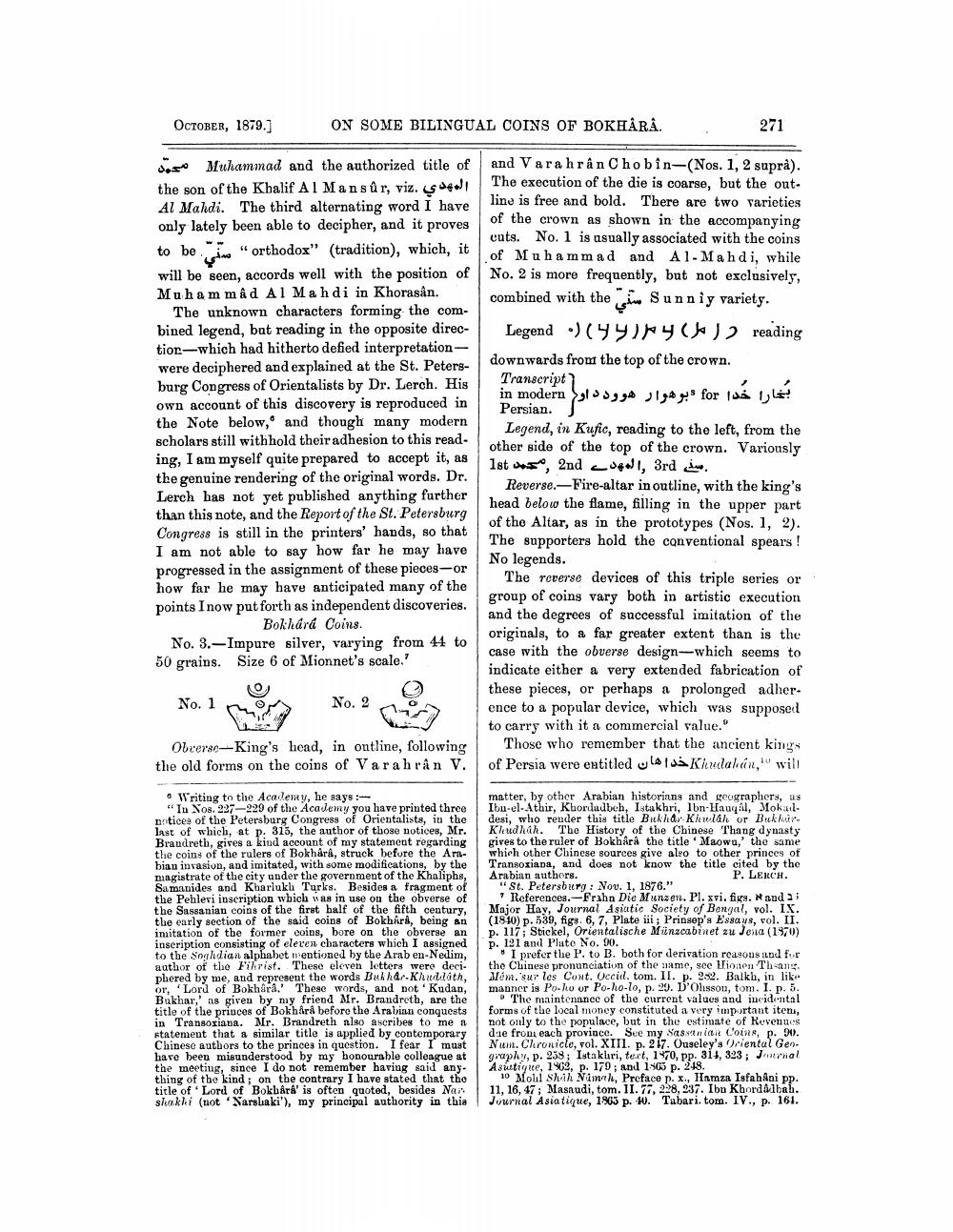________________
OCTOBER, 1879.]
ON SOME BILINGUAL COINS OF BOKHÂRÂ.
271
Muhammad and the authorized title of and Varah rân Chobin-(Nos. 1, 2 supra). the son of the Khalif Al Mansûr, viz. S*41
The execution of the die is coarse, but the outAl Mahdi. The third alternating word I have
line is free and bold. There are two varieties only lately been able to decipher, and it proves
of the crown as shown in the accompanying
cuts. No. 1 is usually associated with the coins to be in " orthodox" (tradition), which, it
of Muhammad and Al-Mahdi, while will be seen, accords well with the position of No. 2 is more frequently, but not exclusively, Muhammad Al Mahdi in Khorasan.
combined with the aim Sunniy variety. The unknown characters forming the combined legend, bat reading in the opposite direc- Legend)(94)14(H)2 reading tior-which had hitherto defied interpretationwere deciphered and explained at the St. Peters
downwards from the top of the crown.
Transcript burg Congress of Orientalists by Dr. Lerch. His
in modern sty les for las ll! own account of this discovery is reproduced in
Persian. J the Note below, and though many modern
Legend, in Kufic, reading to the left, from the scholars still with hold their adhesion to this read
other side of the top of the crown. Variously ing, I am myself quite prepared to accept it, as
1st 2nd I, 3rd de the genuine rendering of the original words. Dr.
Reverse. --Fire-altar in outline, with the king's Lerch has not yet published anything further
head below the flame, filling in the upper part than this note, and the Report of the St. Petersburg
of the Altar, as in the prototypes (Nos. 1, 2). Congress is still in the printers' hands, so that
The supporters hold the conventional spears! I am not able to say how far he may have
No legends. progressed in the assignment of these pieces-or
The reverse devices of this triple series or how far he may have anticipated many of the
group of coins vary both in artistic execution points I now put forth as independent discoveries.
and the degrees of successful imitation of the Bokhará Coins.
originals, to a far greater extent than is the No. 3.-Impure silver, varying from 44 to
case with the obverse design-which seems to 50 grains. Size 6 of Mionnet's scale.'
indicate either a very extended fabrication of
these pieces, or perhaps a prolonged adherNo. 1
ence to a popular device, which was supposed
to carry with it a commercial value." Obrerse-King's head, in ontline, following Those who remember that the ancient kings the old forms on the coins of Varah rán v. of Persia were entitled Uldis Khudalan, will
No. 2
o Writing to the Academy, he says:
"In Xos. 227–229 of the Academy you have printed three notices of the Petersburg Congress of Orientalists, in the last of which, at p. 315, the author of those notices, Mr. Braudreth, gives a kind account of my statement regarding the coins of the rulers of Bokhårå, struck before the Aribian invasion, and imitated, with some modifications, by the magistrate of the city under the government of the Khaliphs, Samanides and Khariukh Turks. Besides a fragment of the Pehlevi inscription which was in use on the obverse of the Sassanian coins of the first half of the fifth century, the early section of the said coins of Bokhara, being an initation of the former coins, bore on the obverse an inscription consisting of eleven characters which I assigned to the Sogndian alphabet mentioned by the Araben-Nedim, author of the Fikrist. These eleven letters were deci phered by me, and represent the words Bukhar-Khulath, or, 'Lord of Bokhara.' These words, and not 'Kudan, Bukhar,' as given by my friend Mr. Brandreth, are the title of the princes of Bokhard before the Arabian conquests in Transoriana. Mr. Brandreth also ascribes to me a statement that a similar title is applied by contemporary Chinese authors to the princes in question. I fear I must have been misunderstood by my honourable colleague at the meeting, since I do not remember having said any. thing of the kind; on the contrary I have stated that tho
tle of Lord of Bokhard' is often quoted, besides Nam shakhi (not 'Xarslaki"), my principal authority in this
matter, by other Arabian historians and geographers, 13 Ibn-el-Athir, Kbordadbeh, Istakhri, Ibn-Hauqal, Mokul. desi, who render this title Buckhar Khwah or BuklurKludhah. The History of the Chinese Thang dynasty gives to the ruler of Bokhårå the title Maowa,' the same which other Chinese sources give aleo to other princes of Transoziada, and does not know the title cited by the Arabian authors.
P. LERCH. "St. Petersburg: Nov. 1, 1876."
References.-Frahn Die Munzen. Pl. xvi. figs. Nand Major Hay, Journal Asiatic Society of Bengal, vol. IX. (1810) p. 539, figs. 6, 7, Plate iii ; Prinsep's Essays, vol. II. p. 117; Stickel, Orientalische Miinacabinet zu Jena (1970) p. 121 and Plato No. 90.
I prefer the P. to B. both for derivation reasons and fur the Chinese pronunciation of the same, see lionen Th-an, Mém. 'sur les Cont. Occid. tom. II. p. 22. Balkh, in like manncr is Po-hu or Po-ho-lo, p. 29. D'Ohsson, tom. I. p. 5.
The maintenance of the current values and incidental forms of the local money constituted a very important iten, not only to the populace, but in the estimate of Revenues die front each province. See my Satnicit Coins, p. 90). Num. Chronicle, vol. XIII. p. 217. Ouseley's Oriental Gen. graphy, p. 258; Istaklari, text, 1970, pp. 314, 323; Journal Astique, 1902, p. 179, and 1505 p. 248.
10 Moll Shuk Nimol, Preface p. x., Hamza Isfahani pp. 1 1, 16, 47; Masudi, tom. II. 77, 228, 237. Ibn Khordalbab. Journal Asiatique, 1903 p. 40. Tabari. tom. IV., p. 161.




